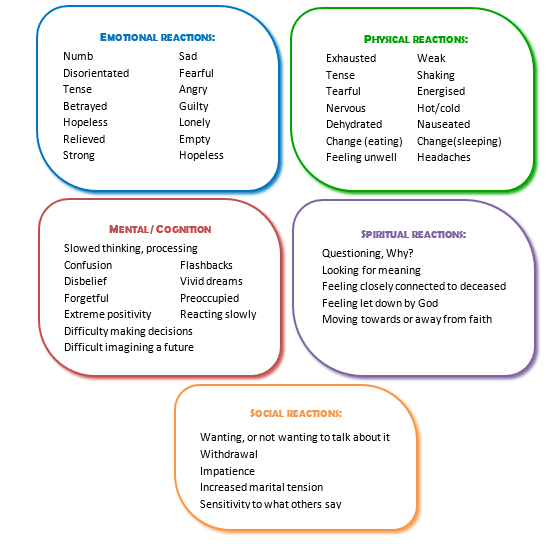Palliative care does not end with the death of a person. Bereavement support, is a key component of quality palliative care, and includes the person, family, whānau and friends as the unit of care. Carers are more likely to have poor health and wellbeing outcomes if they perceive that support has not been available both before and following death of the person they are caring for1.
Death of a loved one is one of the most significant and difficult life events families, whānau and close friends can experience. Grief is a normal human response to difficult loss including death. The grief process assists a person to gradually adjust to the reality of what has happened, experience the pain of the loss and become able to move forward. Grief can disrupt lives, and can be overwhelming. This is a process that takes time, and is individual.
Grief is experienced in different ways including:
- Kind of relationship shared with person who died
- The way on which the person died and if they were present
- Age and stage of development
- Personality
- Gender
- Culture
- Spiritual beliefs
- Pre-existing health conditions
- Usual coping mechanisms
- Previous experience with loss and grief
- Degree of personal support available
Grief affects the whole person, not just a person’s emotions.

Five key areas of a person’s life impacted are:
- Emotions
- Physical
- Mental/ cognition
- Spiritual
- Social
A lack of bereavement support has been linked with poor health outcomes such as depression, social isolation and increased mortality1.
There are common grief reactions, and these can be strong and intense and any mix of them can be experienced simultaneously. Examples include:

Bereavement support begins with preparation for dying, and this should be implemented early. The discussions with whānau, family, and friends should be documented and reviewed regularly by the interdisciplinary team. Services need to be personalised to the person’s age, cultural and belief diversity, disability or gender factors, which may be adversely affecting interpersonal dynamics.
Preparation includes:
- Providing information to family, whānau and friends about what to expect
- Identifying the preferred place of dying
- Providing access to information about post-death factors that are consistent with a family’s, whānau’s or friend’s needs (such as funerals, tangi, or memorials practice options.
- Information needs to be clear, up to date and reliable (written and verbal)
Resources and information for families, whānau’s and friends may be found on the Arohanui website, and include the following:
- What to Expect When Someone is Dying
- Being prepared for Death
- What is grief? Is this Normal?

